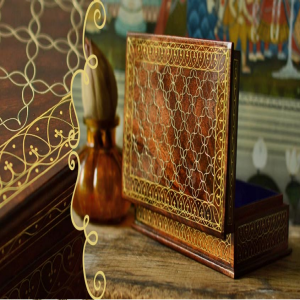- Home
- About US
- Art and Craft
- Artisans
- Master Crafts Persons
- Supporting Institutions
- News and Events
- Schemes
- Contact us
- Contact

In the North western provinces of India, the rich and the wealthy, bored of the contemporary usage of craving on wood desired their doors and storage Sandooks to be ornate with the glitter of silver and gold shining in them, elephant tusk/Ivory taking a popular position amongst them. The Northern provinces have always had bounty skilled craftsmen who could work with their dexterity to create marvels in wood and this reached a new level of finnace and intricacy with Moguls coming in.
At the dawn of 16th century, when the city of Jaipur was being conceptualized, craftsmen from all over the country were invited to aid the settlement with their skills beautification of the city was one of the prime visions of its creator, Sawai Maansingh II and it still continues to attract both artisans and their patrons to visit the city or even live there. Maharaja Jai Singh II. with his tactfulness and exceptional leadership qualities won the title of ‘Sawai’ (One and a quarter) from Emperor Aurangzeb and was enthroned the ruler of Amber. During his reign, he also simultaneously pursued higher education and expanded his knowledge of arts and sciences.
Apart from building Jantar Mantar and many beautiful building, he also invited many craftsmen across India to fulfill city’s need. Amongst these were the artisans of ‘Taarkashi’, who migrated to the city from Mainpuri, Uttar Pradesh. Right from beautifully carved and decorated with silver and later with brass wires boxes to door panels, to treys and lamps, to sandook (chest), decorative elephants, tables, flower pots etc the artisans of Taarkashi have stretched the magic of their silver through generations. Taar means wire, technique of inlaying fine flattened wire of brass, copper or silver in wood is called Taarkashi. The patterns inlayed are usually geometric forms or florals from Mughal arts. Metal inlay is a painstaking and highly skilled process. The artisan transfers a design from a piece of paper onto a block of wood. He then carves deep, thin grooves along the trace.
Fine wires of brass are placed in the grooves and hammered into position. The inlaid wire sits flush with the surface of the wood. Finishing is done by buffing, care being taken not to heat the product, as that would dislodge the wires.

